2013 年北京科技大学基础英语考研真题
北 京 科 技 大 学
2013 年硕士学位研究生入学考试试题
==============================================================================
试题编号: 618
试题名称:
基础英语
适用专业: 外国语言文学(包括外国语言学及应用语言学和英语语言文学)
说明: 所有答案必须写在答题纸上,做在试题或草稿纸上无效。
==============================================================================
Part Ⅰ Vocabulary (30 minutes, 30 points, 1 point each)
Section A
Directions: There are fifteen incomplete sentences in this section. For each
sentence there are four choices marked A, B, C and D. Choose the ONE that best
completes the sentence.
B. as
D. more as
B. But with
C. but
D. or
B. at best
C. for all
D. by far
C. Except for
D. As are
a musician than her brother.
B. much as
C. more of
the most imaginative of all the contemporary poets.
my family’s consistent encouragement I wouldn’t have accomplished my
1. In my opinion, he’s
A. in all
2. The chief reason for the population growth isn’t so much a rise in birth rates
a fall in death rates as a result of improvements in medical care.
A. and
3. She is
A. much of
4.
graduate study.
A. But for
5. Just as there are occupations that require college or even higher degrees,
occupations for which technical training is necessary.
A. so too there are
are there
6. In such desperate strains did he find himself that he was reduced to
violin in the streets.
A. play
7. Those twins are so alike that it is next to impossible to distinguish
A. who is who
8. He is determined to prove his innocence,
A. even though
9. When the young man realized that the police had spotted him, he made
the
exit as quickly as possible, only to find that two policemen were waiting outside.
A. off
C. towards
10. The stark reality is that our education system
he has to go to the highest court.
B. which is which
C. one and the other
D. one another
people, but industry does
B. so also there are
C. so there are too
D. so too
D. having played
B. playing
C. be playing
B. even as
C. even if
D. even so
the
.
B. from
D. for
�
loose.
D. felt
B. felt like
D. bring out
C. churns out
C. was feeling
B. produces out
not find them useful.
A. turns out
11. On that rainy night, John told his father that the lock on the door
A. was felt
12. Critics charge that this is partly because Europe is still moving slowly to
government stimulus programs and right its own ailing financial system.
A. roll back
13.
A. Not until he arrived
C. Hardly had he arrived
14. Noise pollution generally receives less attention than
A. does
15.
is actually the favorite vegetable, according to the poll done.
A. Actually
B. No sooner had he arrived
D. Scarcely did he arrive
corn is usually believed to be the American favorite vegetable, broccoli
when she started complaining.
D. it does over
air pollution.
B. roll down
D. roll out
C. receives
C. roll in
B. it does
D. Despite
B. However
C. While
Section B
Directions: There are ten sentences in this section with one word or phrase
underlined in each sentence. From the four choices given, choose one that best
explains or defines the underlined part in each sentence.
D. resume
C. restock
C. seminars
B. recollect
C. classification
B. categorization
B. groups of experts
16. Scientific evidence from different disciplines demonstrates that for most humans
the left half of the brain controls language.
A. fields of study
D. regulations
17. Your analogy was not a good one because the two situations are not similar.
A. comparison
D. cognition
18. The conquerors stole not only the gold and silver that were needed to replenish
the badly depleted treasury but also the supplies that were vital to the nation.
A. substitute
19. Whenever he goes, he readily accommodates to new circumstances.
A. finds a lodging in
C. provides lodging for
20. Even after ten years her name conjures up such beautiful memories.
A. covers up
21. Many of his arguments have no pertinence to the subject under discussion.
A. significance
22. The graduate committee must be in full accord in their approval of a dissertation.
A. indecisive
23. We regret being unable to entertain your request for providing free boarding
to 15 sportsmen for two weeks.
A. receive
24. The artist spent years on his monumental painting, which covered the whole roof
of the church, the biggest in the country.
A. archaic
B. makes a close study of
D. adapts himself to
C. brings to mind
C. enlightenment
B. sentimental
C. outstanding
D. unanimous
D. relevance
C. coincide
D. consider
D. makes up
B. reveals
B. sullen
D. entire
B. value
B. comply
C. vocal
�
25. The ancient Jewish people regarded themselves as the salt of the earth, the chosen
few by God.
A. outcast
D. disciple
B. elite
C. nomad
Section C
Directions: Eachofthefollowingfivesentencesbelowhastwoblanks,eachblank
indicatingthatsomethinghasbeenomitted.Beneaththesentencearefivelettered
orsetsofwords.Choosethewordorsetofwordsforeachblankthatbestfitsthe
meaning of the sentence.
B. convincing…held
C. honest… found
D. true…
the power to make himself believed.
B. refined… upgraded
D. used… supplemented
26. Eric was frustrated because, although he was adept at making lies sound
when telling the truth, he
A. plausible…lacked
acquired
27. The techniques now available to livestock breeders will continue to be
but will probably be
A. fruitful… reversed
C. inconvenient… reassessed
28. Any population increase beyond a certain level necessitates greater
vegetable foods; thus, the ability of a society to choose meat over cereals always
arises, in part, from
A. production of … estimating
C. recourse to … limiting
29. Since 1813 reaction to Jane Austen’s novels has oscillated between
and condescension; but in general later writers have esteemed her works more highly
than did most of her literary
A. dismissal…admirers
C. disapproval…readers
30. The actual
refusal to compromise after having initially agreed to negotiate a settlement.
A. outcome…foreshadowed
C. rigidity…betrayed
B. adoration… contemporaries
D. indifference…followers
B. spending on … concealing
D. attention to… varying
of Wilson’s position was always
B. logic…enhanced
D. uncertainty… alleviated
by his
by new ones under development.
the number of people.
.
Part Ⅱ Proofreading and error correction (20 minutes, 20 points, 2 points each)
Directions: ThefollowingpassagecontainsTENerrors.Eachindicatedlinecontains
amaximumofONEerror.Ineachcase,onlyONEwordisinvolved.Youshouldproof-read
the passage and correct it in the following way.
For a wrong word,
underline the wrong word and write the correct one in
For a missing word,
the blank provided at the end of the line.
mark the position of the missing word with a “∧”
sign and write the word you believe to be missing in the
blank provided at the end of the line.
For an unnecessary word,
cross out the unnecessary word with a slash “/” and
�
put the word in the blank provided at the end of the line.
Example
When∧art museum wants a new exhibit,
it never buys things in finished form and hangs
them on the wall. When a natural history museum
wants an exhibition, it must often build it.
1.
an
2.
never
3.
exhibit
the
In
an
fertile
minds
of
on
e-mail,
interview
children.
In his 1988 best seller A Brief History of Time, Stephen Hawking
made readers wonder: if the universe is expanding, where is it expanding
to?
Now Hawking has teamed up his daughter, Lucy Hawking, to write
(1)
George’s Secret Key to the Universe, the first in a trilogy of novels directed
at
Hawking
(2)
explains: “The aim of the book is to encourage children’s sense of wonder
at the universe. We want them to look up outward only then will they
be able to make the right decisions to safeguard the future of the human
race.”
George’s Secret Key to the Universe, aimed 9-11-year-olds,
tells the story of a young boy, George, and a cheery astrophysicist,
Eric, who talking computer opens a portal to the unknown universe. The
duo make spacesuits and use the portal to search for planets to which
humanity can escape the irreversible warming of the earth. Along the way,
George and the reader learn from the basics of astrophysics and astronomy
through illustrations and captioned photographs. “You don’t need
actual secret key to explore the universe, ” George ultimately discovers.
(8)
“There’s one that everyone can use. It’s called physics.”
The Hawkings portray the universe as harmony and largely benign.
But our present knowledge of the universe suggests that is, in fact, a
desolate and often violent expanse place in which humankind plays an
inconsequential role.
(6)
(7)
(4)
(5)
(3)
(9)
(10)
Part III Reading Comprehension (50 minutes, 40 points, 2 points each)
Directions: There arefourpassagesin thispart.Readeachpassagecarefully and
answer the questions following each passage as you are required.
Passage One
Modern industrial society grants little status to old people. In fact, such a
society has a system of built-in obsolescence. There is no formal system for
continuing our education throughout our life in order to keep up with rapidly
changing knowledge. When our education and job skills have grown obsolete, we are
treated exactly like those who have never gained an education or job skills and are
not encouraged or given the opportunity to begin anew.
�
As a society becomes more highly developed, the overall status of older people
diminishes. Improved health technology creates a large pool of old people, who
compete for jobs with the young. However, economic technology lowers the demand for
workers and creates new jobs for which the skills of the aged are obsolete, forcing
older people into retirement. At the same time, young people are being educated in
the new technology and are keeping pace with rapid changes in knowledge. Finally,
urbanization creates age-segregated neighborhoods. Because the old live on fixed
incomes, they must often live in inferior housing. All these factors — retirement,
obsolete knowledge and skills, inferior standards of living — lower the status of
the aged in society.
.
.
A century ago, when one could expect to live only to 50 or so, the life span
more or less coincided with the occupation and family cycle. But today the average
life span allows for fifteen to twenty years of life after these cycles. It appears
that our life span is outpacing our usefulness in society.
1. By “a system of built-in obsolescence” the author means
A. no formal system exists in modern industrial society
B. old people have no status in modern industrial society
C. young people have chances in modern industrial society
D. knowledge changes rapidly in modern industrial society
2. The more highly developed a society is,
A. the more advanced technology will be
B. the larger the number of people will be
C. the more diminished old people’s status will be
D. the lower the overall status of the old people will be
3. Which of the following statement is NOT true?
A. Retired people could only live on fixed incomes.
B. Retired people are more skillful than young people.
C. Young people are educated in the new technology.
D. Young people are keeping pace with rapid changes.
4. The sentence “our life span outpaces our usefulness” means we can live
longer
A. and make progress
C. but move slowly
5. The author’s attitude toward the aged is
A. realistic
B. and do more work
D. but become useless
D. sympathetic
.
B. optimistic
C. pessimistic
.
Passage Two
“First they ignore you, then they laugh at you, then they fight you, then you
win.” Mahatma Gandhi probably never said these words, despite claims to the contrary,
but they perfectly describe the progress of open-source software over the past 15
years or so. Such software, the underlying recipe for which is created by volunteers
and distributed free online, was initially dismissed as the plaything of nerdy
hobbyists. Big software firms derided the idea that anyone would put their trust
in free software written by mysterious online collectives. Was it really secure?
�
Whom would you call if it went wrong?
At the time, selling software to large companies was sometimes likened to drug
dealing, because once a firm installed a piece of software, it had to pay a stream
of licence fees for upgrades, security patches and technical support. Switching to
a rival product was difficult and expensive. But with open-source software there
was much less of a lock-in. There are no licence fees, and the file formats and data
structures are open. Open-source software gained ground during the dotcom boom and
even more so afterwards, as a way to cut costs.
Microsoft, the world’s biggest software company, went from laughing at the
idea to fighting it, giving warning that there might be legal risks associated with
using open-source software and even calling it a “cancer” that threatened to harm
the industry. Yet the popularity of open-source programs such as the Linux operating
system continued to grow. The fact that Google, the industry’s new giant, sits on
a foundation of open-source code buried the idea that it was not powerful or reliable
enough for heavy-duty use. One by one the industry’s giants embraced open source.
Even Microsoft admits that drawing on the expertise of internet users to scrutinize
and improve software has its merits, at least in some cases.
The argument has been won. It is now generally accepted that the future will
involve a blend of both proprietary and open-source software. Traditional software
companies have opened up some of their products, and many open-source companies have
adopted a hybrid model in which they give away a basic version of their product and
make money by selling proprietary add-ons. The rise of software based on open,
internet-based standards means worries about lock-in have become much less of a
problem.
But now there is the danger of a new form of lock-in. “Cloud computing”—
the delivery of computer services from vast warehouses of shared machines—enables
companies and individuals to cut costs by handing over the running of their e-mail,
customers databases or accounting software to someone else, and then accessing it
over the internet. There are many advantages to this approach for both customers
(low cost, less complexity) and service providers (economies of scale). But
customers risk losing control once again, in particular over their data, as they
migrate into the cloud. Moving from one service provider to another could be even
more difficult than switching between software packages in the old days. For a
foretaste of this problem, try moving your MySpace profile to Facebook without
manually retyping everything.
The obvious answer is to establish agreed standards for moving data between
clouds. An industry effort to this effect kicked off in March. But cloud computing
is still in its infancy, and setting standards too early could hamper innovation.
So buyers of cloud-computing services must take account of dangers of lock-in, and
favour service providers who allow them to move data in and out of their system
without too much hassle. This will push providers to compare on openness from the
outset—and ensure that the lessons from the success of open-source software are
not lost in the clouds.
6. Which of the following best describes the author’s attitude towards the
�
C. Supportive
D. Enthusiastic
B. Contemptuous
open-source software?
A. Skeptical
7. Why would the author describe software selling as drug dealing?
A. It is illegal.
B. It costs huge “running money” after first time purchasing.
C. It is hard to stick to software.
D. It comes with virus.
8. Which of the following facts is not the reason for Microsoft to change its view
on open-source software?
A. Linux uses open-source software.
B. Google is based on open-source code.
C. Open-source software is proved to be reliable for heavy-duty running.
D. The number of open-source program is increasing.
9. Which of the following statements is true about the future of open-source
software?
A. It will transform into a private owned property which can be better protected.
B. Traditional software can only earn money from value-added services.
C. Users may be less worried about the losing of data by using open-based program.
D. Open-source program is always free of charge.
10. Which of the following statements is true about “cloud computing”?
A. It is an online program such as Facebook or Myspace.
B. It may hamper innovation.
C. It intends to provide a third party database for data owner and service provider.
D. It may cause data losing in the cloud.
Passage Three
The Roman language served as the first model for answering the question. Even
to someone with no knowledge of Latin, the similarities among Roman languages would
have made it natural to suggest that they were derived from a common ancestor. On
the assumption that the shared characteristic of these languages came from the common
ancestor, it would have been possible to reconstruct many of the characteristics
of the original common language. In much the same way it became clear that the
branches of the Indo-European family could be studied and a hypothetical family tree
constructed, reading back to a common ancestor. This is the tree approach. The basic
process represented by the tree model is one of divergence: when languages become
isolated from one another, they differ increasingly, and dialects gradually become
different until they become separate languages.
Divergence is by no means the only possible tendency in language evolution.
Johannes Schmidt introduced a “wave” model, in which linguistic changes were like
waves, eventually leading to convergence; that is, growing similarity among
languages that were initially quite different.
Today, however, most linguists think primarily in terms of family trees. It is
necessary to construct some models of how language change might occur according to
a process-based view. There are four main classes of models.
�
.
The first is the process of initial colonization, by which an uninhabited
territory becomes populated; its language naturally becomes that of the colonizers.
Second are processes of divergence, such as the linguistic divergence arising from
separation or isolation mentioned above in relation to early models of the
Indo-European languages. The third group of models is based on processes of
linguistic convergence. The wave model, formulated by Schmidt in the 1870’s, is
an example, but convergence methods have not generally found favor among linguists.
Now, the slow and rather static operation of these processes is complicated by
another factor: linguistic replacement. That factor provides the basis for a fourth
class of models. In many areas of the world the languages initially spoken by the
indigenous people have come to be replaced, fully or partially, by languages spoken
by people coming from outside. Were it not for this large complicating factor, the
world’s linguistic history could be faithfully described by the initial
distribution of Homo Sapiens, followed by the gradual workings of divergence and
convergence. So linguistic replacement also has a key role to play in explaining
the origins of the Indo-European languages.
11. The characteristics of the original common language can be described on the basis
of
A. the similarities among Roman languages
B. the hypothetical family tree
C. the process known as divergence
D. the common features of Roman languages
.
12. According to Johannes Schmidt,
A. languages change on a large scale like waves
B. divergence is not the only possible tendency in language change
C. language evolution can be explained in terms of divergence and convergence
D. different languages will become increasingly similar until they develop into one
language
13. It can be inferred from paragraph 4 that
A. there doesn’t exist any satisfactory model of language change
B. most linguists explain language change only in terms of divergence
C. most linguists generally don’t accept the idea of language convergence
D. the first process in language evolution is colonization, followed by divergence
14. Which of the following is TRUE according to the passage?
A. Linguistic replacement can be ignored for the linguistic history to be fully
described.
B. Linguistic replacement cannot be ignored in explaining where the Indo-European
languages come from.
C. Because of linguistic replacement, the other three models prove to be incorrect.
D. Compared with the other models, linguistic replacement is the most important
model.
15. This passage is primarily written to
.
A. discuss the importance of linguistic replacement
B. introduce the origin of the Indo-European language
.
�
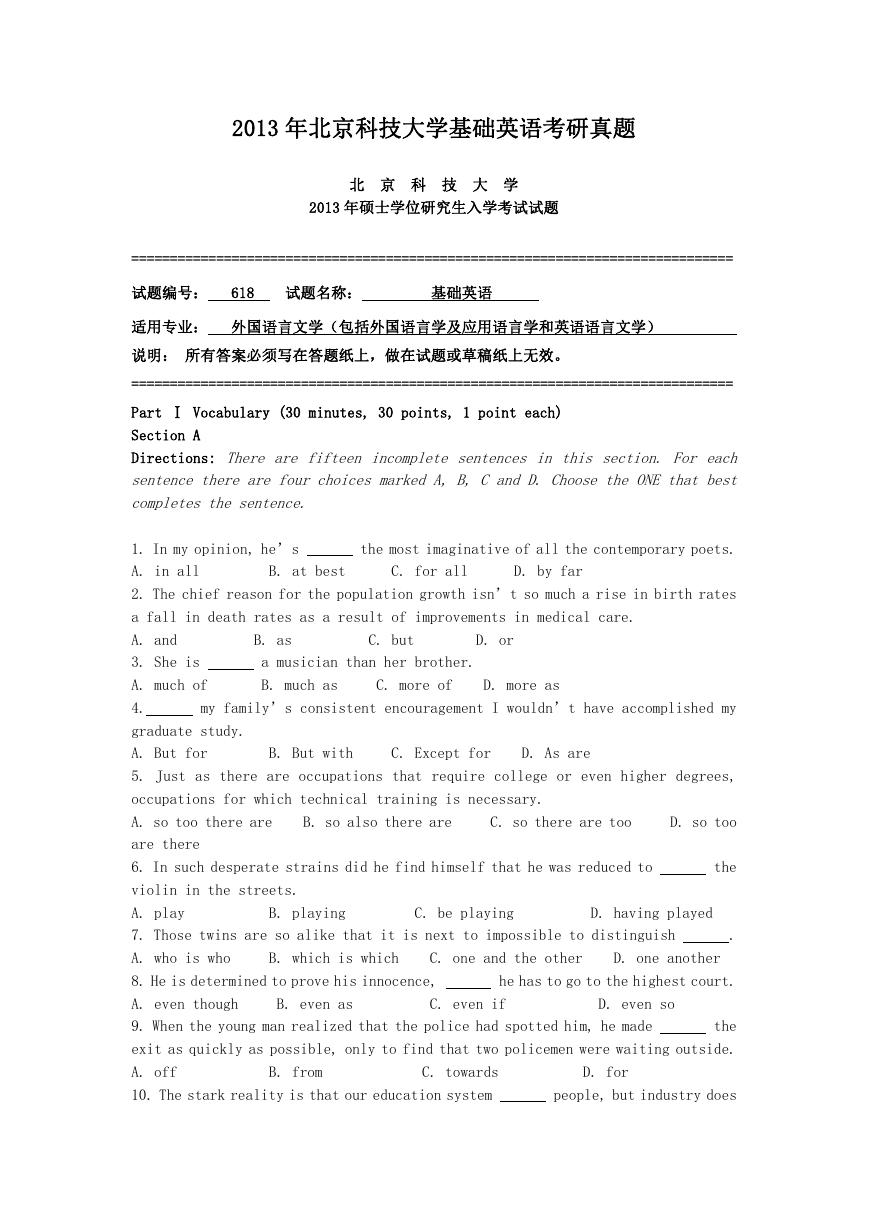
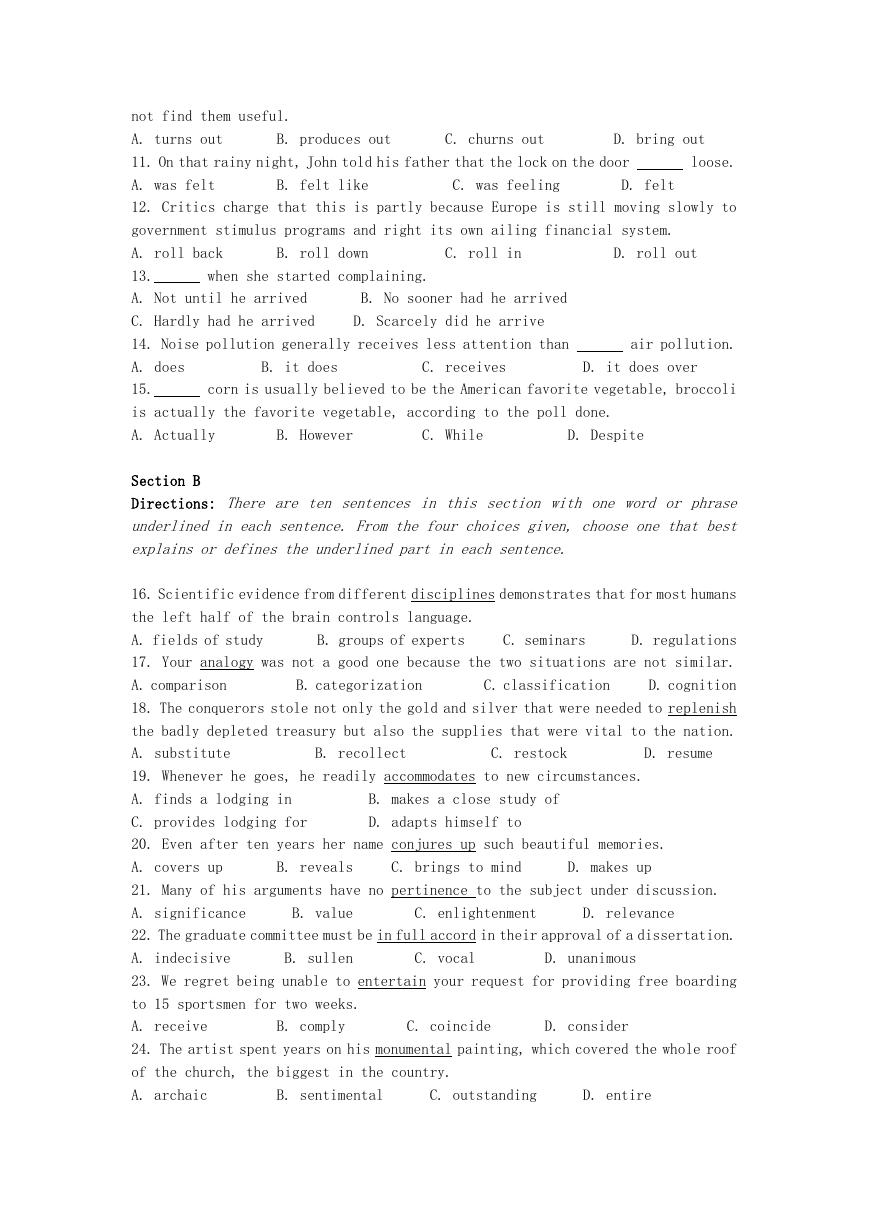
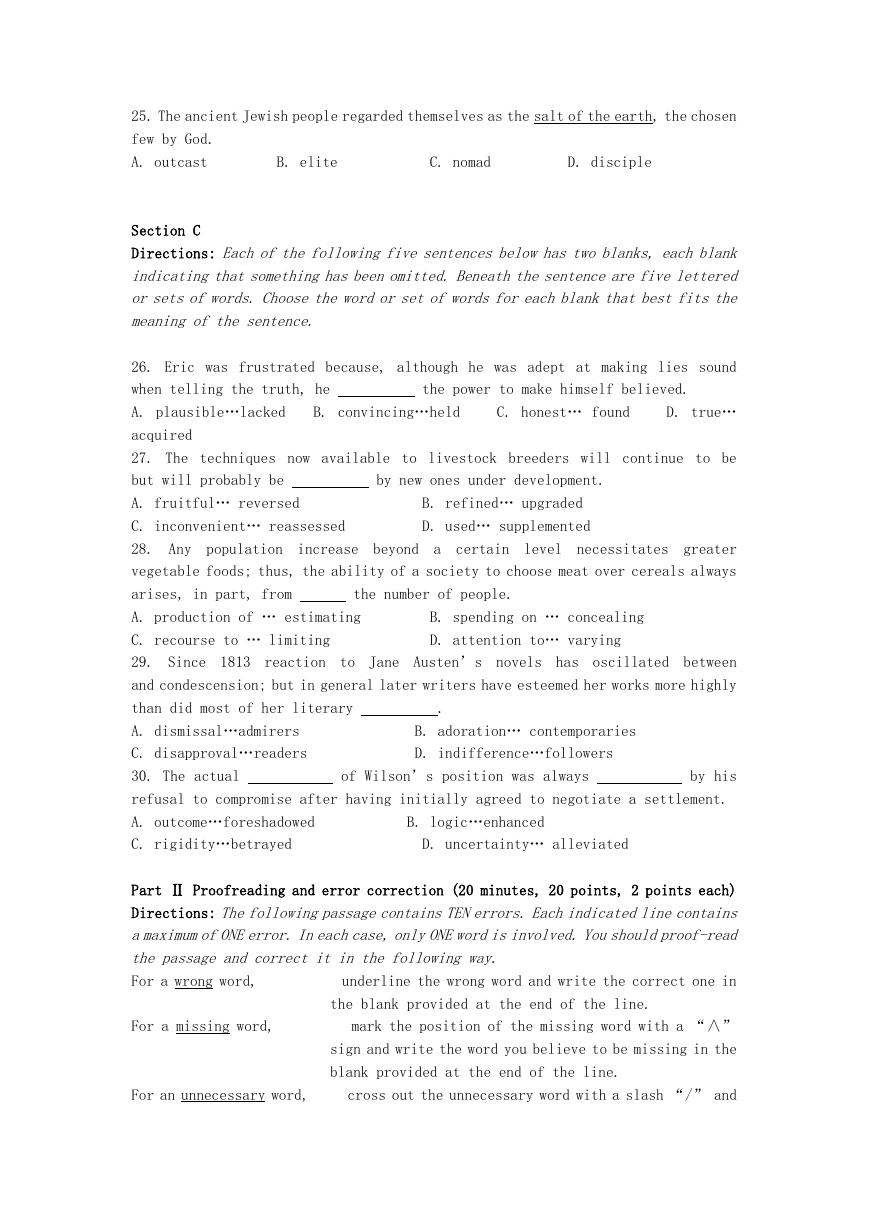
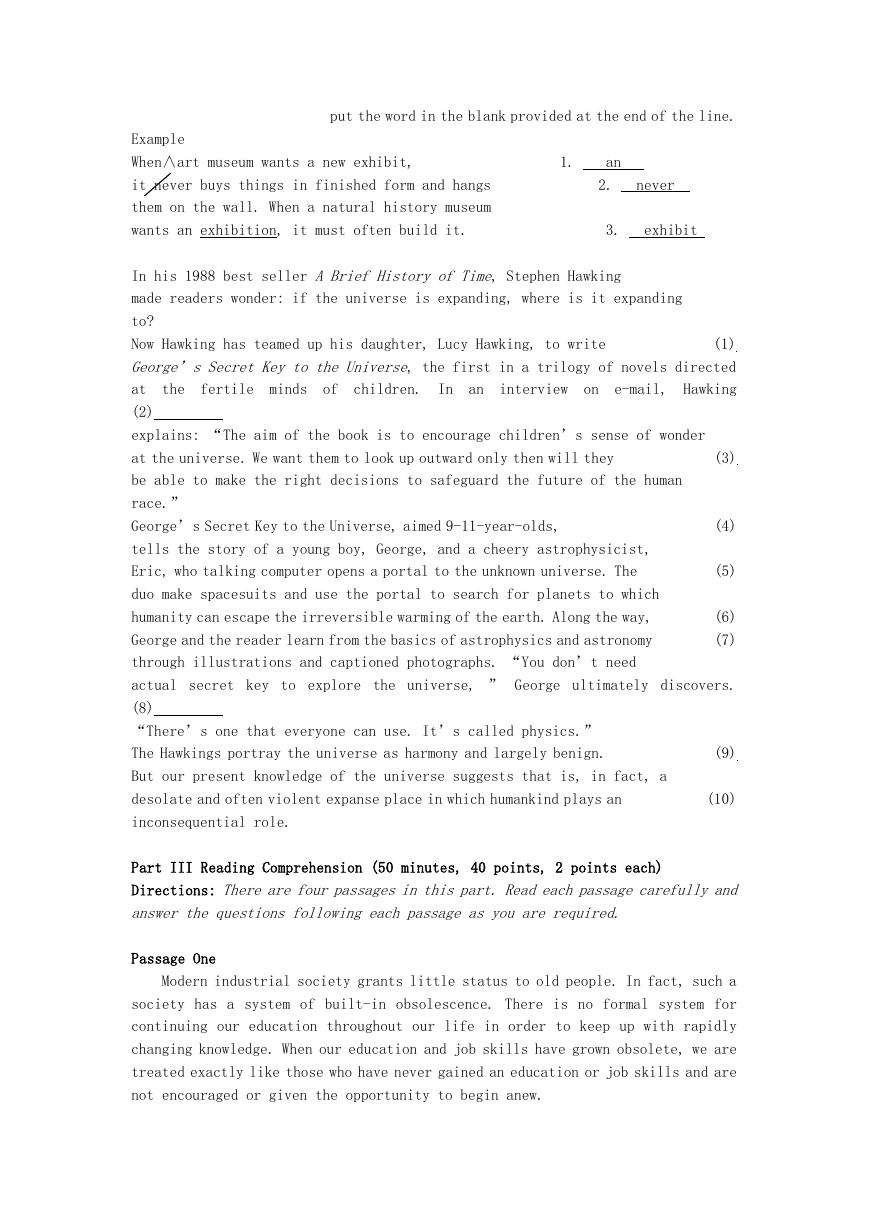
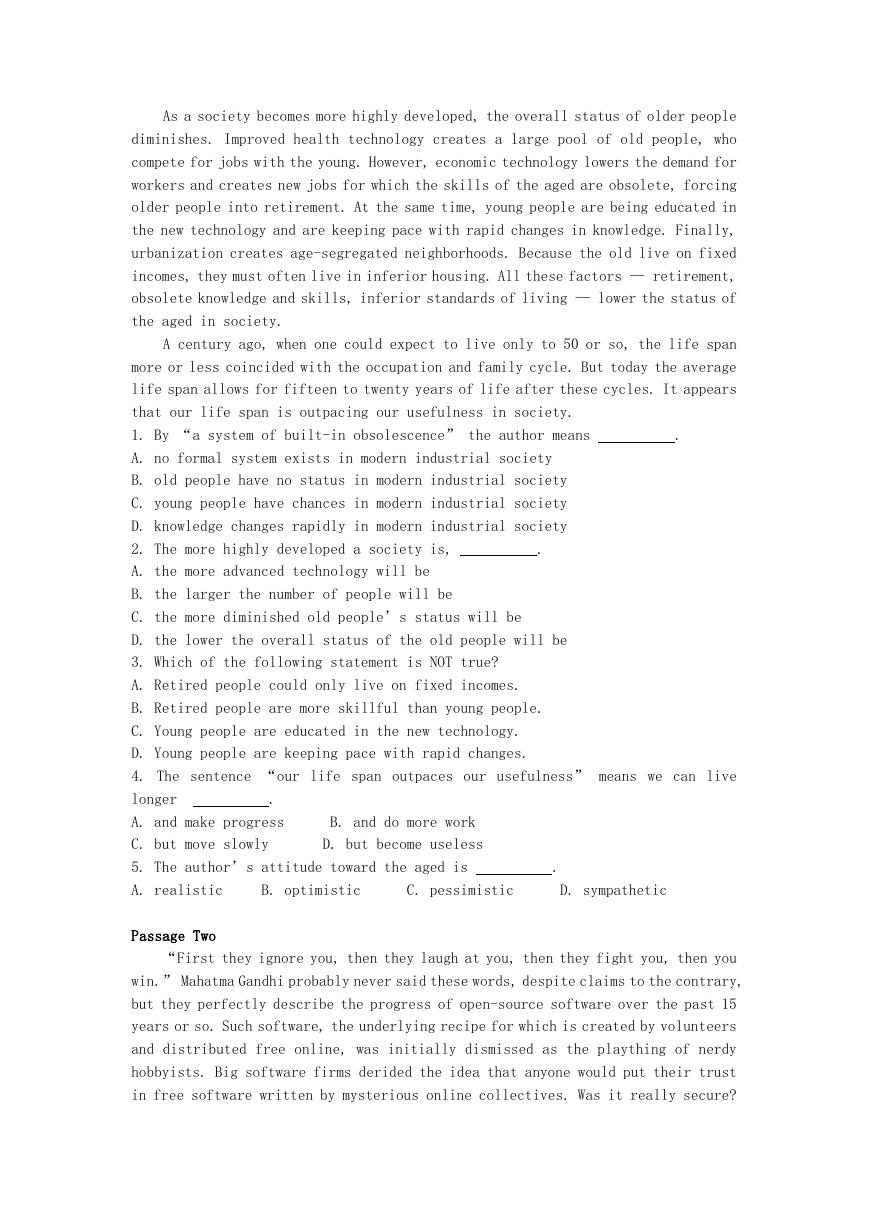
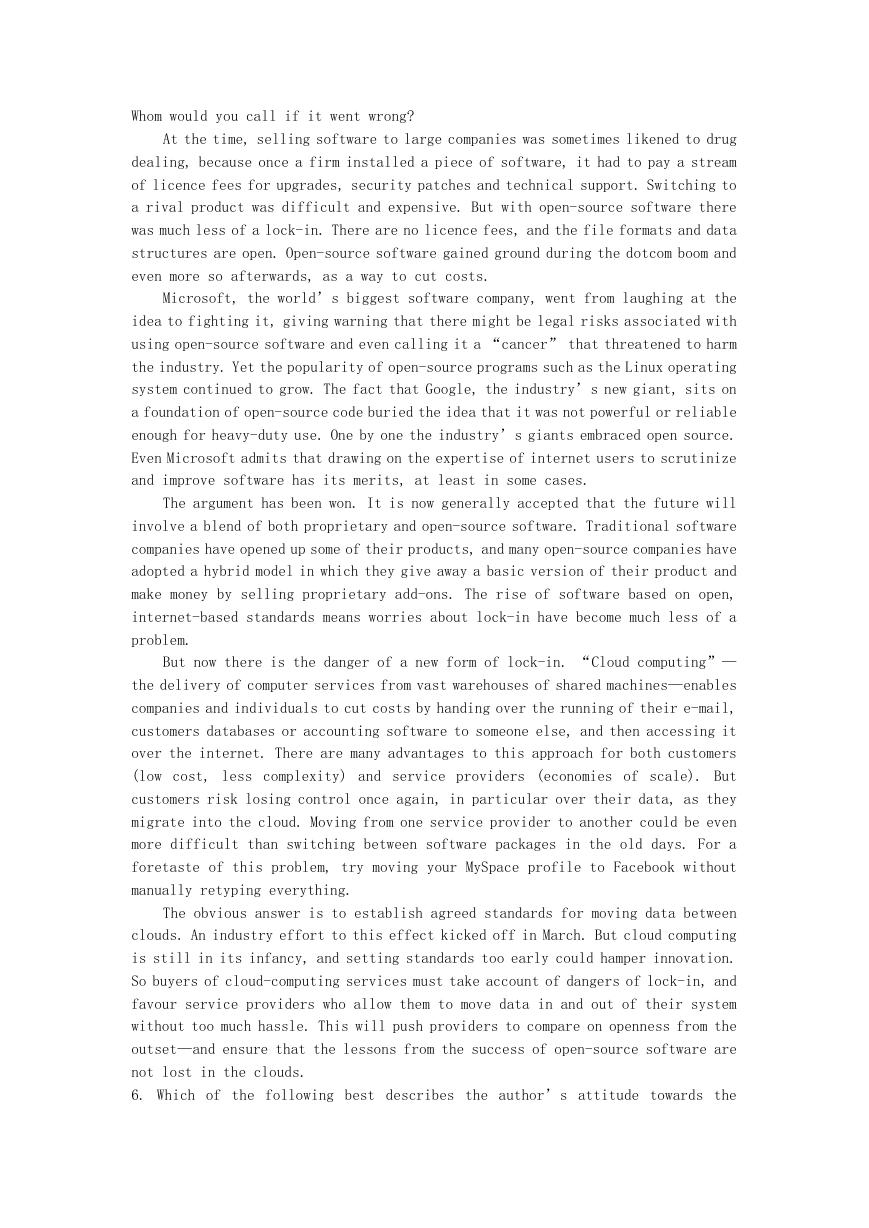
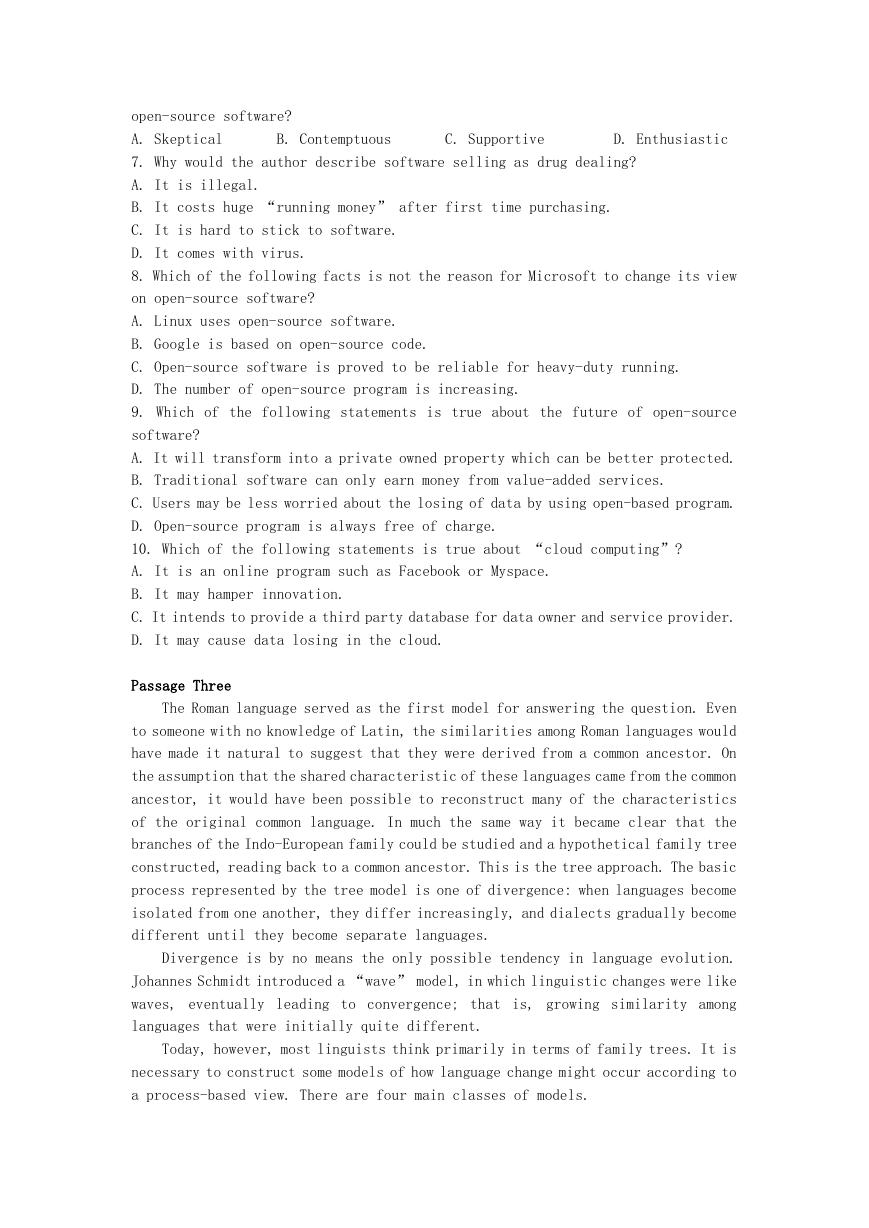









 2023年江西萍乡中考道德与法治真题及答案.doc
2023年江西萍乡中考道德与法治真题及答案.doc 2012年重庆南川中考生物真题及答案.doc
2012年重庆南川中考生物真题及答案.doc 2013年江西师范大学地理学综合及文艺理论基础考研真题.doc
2013年江西师范大学地理学综合及文艺理论基础考研真题.doc 2020年四川甘孜小升初语文真题及答案I卷.doc
2020年四川甘孜小升初语文真题及答案I卷.doc 2020年注册岩土工程师专业基础考试真题及答案.doc
2020年注册岩土工程师专业基础考试真题及答案.doc 2023-2024学年福建省厦门市九年级上学期数学月考试题及答案.doc
2023-2024学年福建省厦门市九年级上学期数学月考试题及答案.doc 2021-2022学年辽宁省沈阳市大东区九年级上学期语文期末试题及答案.doc
2021-2022学年辽宁省沈阳市大东区九年级上学期语文期末试题及答案.doc 2022-2023学年北京东城区初三第一学期物理期末试卷及答案.doc
2022-2023学年北京东城区初三第一学期物理期末试卷及答案.doc 2018上半年江西教师资格初中地理学科知识与教学能力真题及答案.doc
2018上半年江西教师资格初中地理学科知识与教学能力真题及答案.doc 2012年河北国家公务员申论考试真题及答案-省级.doc
2012年河北国家公务员申论考试真题及答案-省级.doc 2020-2021学年江苏省扬州市江都区邵樊片九年级上学期数学第一次质量检测试题及答案.doc
2020-2021学年江苏省扬州市江都区邵樊片九年级上学期数学第一次质量检测试题及答案.doc 2022下半年黑龙江教师资格证中学综合素质真题及答案.doc
2022下半年黑龙江教师资格证中学综合素质真题及答案.doc